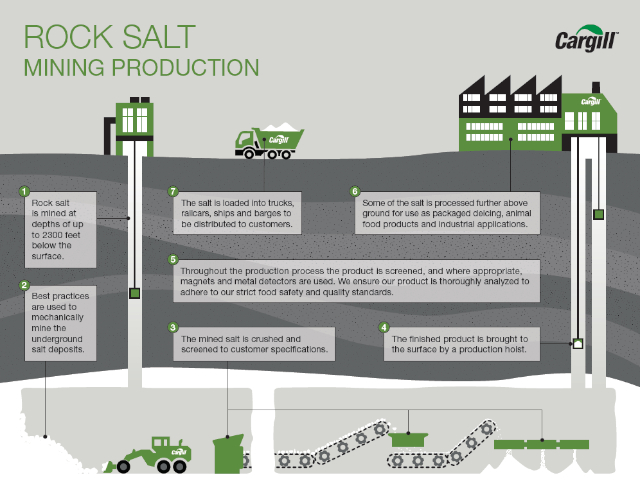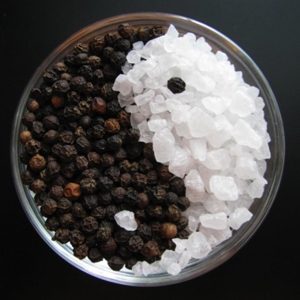I was cruising home, after spending Mother’s Day morning with my ancient and venerable Mom at the nursing home, when I accidentally tuned-in to an all-talk radio station. The host was interviewing folks about a current fad: ‘healthy’ salt…
 The preponderance of table salt today is still hard-rock mined by outfits
The preponderance of table salt today is still hard-rock mined by outfits
such as Cargill, according to the process outlined above…
Wait! What was that?
I’ve been taught, by chefs, nutritionists and medical people, that salt is salt is salt. All forms, colours, flavours and provenances of salt are basically sodium chloride. They all pose an equal risk to folks who are prone to heart disease, high blood pressure and stroke.
So why are so many evangelists taking up pulpits these days extolling the almost magical virtues of of ‘natural’, ‘mountain’, ‘desert’ and ‘sea’ salts? I decided to do a little research and find out how – if at all – these exotic variants on good old table salt vary fundamentally from the stuff we get at the supermarket.
Nope… Salt IS salt is salt
Salt is just about as simple a chemical formula (NaCl) as you can imagine: two basic elemental mineral substances – sodium and chlorine – in a small, compact chemical package conveniently designed to deliver those essential substances to our bodies.
A bonus function is that salt also tweaks our taste and smell systems to help us enjoy our food more. In that sense, salt is unique. In company with pepper (see photo, top of page) – an organic source of sensory stimulation – salt constitutes what we in the food biz call a ‘seasoning’. Everything else out there on nature’s broad and beautiful palette of flavour enhancers is fundamentally organic, and falls into into one of two categories: herbs or spices.
Then, of course, there’s MSG. It comes from an organic source (traditionally), is extracted and refined into a simpler mineral form, and then dances out onto the culinary stage in a special spotlight all its own. But when it comes right down to it, MSG – monosodium glutamate – is just another source of sodium; the same as we get from table salt. And the same health caveats apply.
The truth is…
“Technically, all salt is sea salt — even table salt, which is mined from rock (aka halite) that was formed by ancient bodies of water that no longer exist,” according to Country Living.com. “But even so, not all salts are the same nor should they be used in the same way.”
And don’t forget that Table Salt is a designation that tells you your supermarket crystals are fortified with iodine, which is essential to thyroid health, but is typically deficient in our regular daily diets. ‘Table Salt’ is also typically refined and processed to remove other minerals and contaminants. ‘Sea’ and other ‘natural’ salts are usually not refined or processed in any way.
Old wives’ tales, marketing bumpf, food snobs
So where did all these claims about other ‘salts’ come from, anyway? There are many different ways that stories – in some cases, legends – about other ‘salts’ have entered the common mythology and usage. Old wives’ tales, marketing bumpf, food snobs, and many other channels have also contributed to the infusion of salt mythology into our world.
For example:
Sea salt is all the rage right now. That’s really just the salty crystals left over after the water has been evaporated to leave crystals of the solids that were dissolved in it originally. Now, grant you, that can and does vary with where in the world you ‘harvest’ your sea water. What you get when you evaporate the unwanted H20 from your sea water depends on the minerals that were naturally present in the rocks around and about the place you gathered your water.
Naturally, that leaves a lot of room for really nasty, noxious or downright deadly stuff to leech into the seawater, depending on where you are. I was glad to hear the ‘natural’ salt evangelist on the radio stress, at one point, that all fancy salts are thoroughly tested for bad stuff before they’re okayed for sale. I would have assumed the various government health and safety agencies would demand such testing, anyway. On checking, I discovered I was correct.
Trademark colours, flavours and textures
So what gives ‘natural’ salts the trademark colours and flavours they are so prized for? Simple. Other minerals and compounds in the rocks where the salt occurs, usually dissolved in the water with the salt.
I’ll concede that some fancy salts do have trademark flavours and colours. But the vast majority of those are not nutritive components. They simply do no harm while looking nice tasting intereting. And you pay through the nose for them.
Most salts depend on the method(s) by which they’re harvested, for the textures they end up with when they reach your kitchen. Many sea salts are not crystals but flakes, which are flat platelets of the various mineral components in the water they came from. Like snow flakes are flat lattices of ice crystals.
A few ‘natural’ salts are actually noteworthy
… For their additional mineral contents:
According to Country Living.com, “Himalayan pink salt is harvested from the Khewra Salt Mine in the Himalayan Mountains of Pakistan. Easily recognizable because of its pink color, this salt contains all 84 natural minerals found in the human body. Because of its steep price tag and bold flavor, use Himalayan pink salt for finishing dishes.”
Likewise, “Red Hawaiian salt is sea salt that is mixed with iron oxide-rich volcanic clay. Its flavor is described as nutty. Its striking red color makes it perfect for garnishing finished dishes.”
Some ‘common’ fancy salts are ‘processed’
There are salts that some cooks covet which do not occur in nature. For instance:
‘Black’ salts are the result of processors adding activated charcoal and sometimes other things to regular salt.
Smoked Salts are created by cold smoking salt with wood (such as alder, apple, hickory, or mesquite).
The quick reference I’ve bookmarked…
… Is this clear, concise article from CountryLiving.com that I mentioned above. Any other ‘salts’ that fall outside its realm are probably represented by a sibling or close cousin in this master list.
My take
Bottom line? Don’t be bamboozled by the pletho0ra of rare, exotic or ‘special-source’ salts out there on the ‘gourmet’ market. You may, at one time or another, have some special reason to seek out some other kind of salt than good old NaCl. But just remember: When it comes right down to it, salt is salt is salt…
~ Maggie J.

